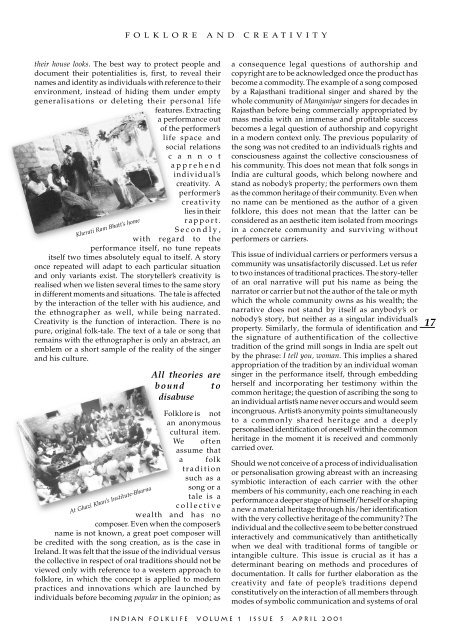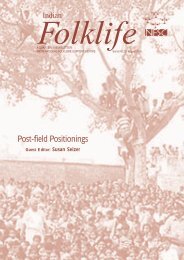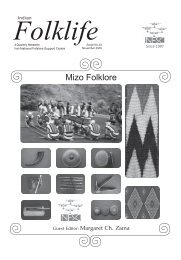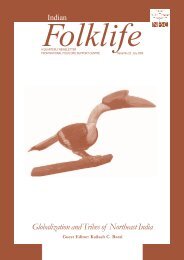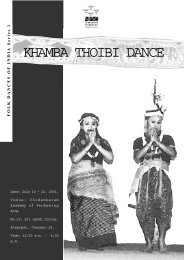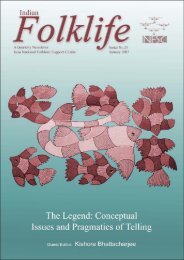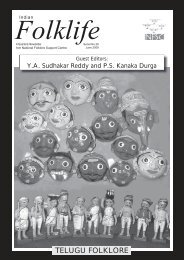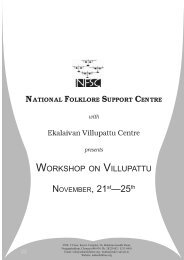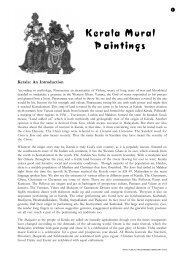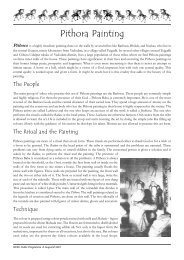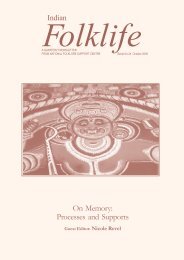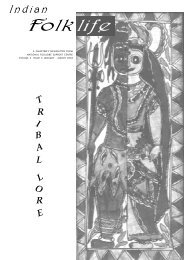FOLKLORE AND CREATIVITY16Cultural memory may draw upon the inner dynamicsof old folk forms and incorporate their semantics andvalues in a new life style, in different systems of socialrelations. Why should we not even continue using oldinstruments and react against their falling out of use?A mental shift is needed to prompt new people to adjustto old instruments on account of their musical potentials.Why not create this opportunity and device a new leaseof life for them in our times? remarked Komal Kothari.From the outset, a kind of principle for action wasstressed, namely, that at a time when many traditionalforms are disappearing, these forms should be carefullydocumented and systematically studied for whateverthey are worth for (social form, musical tune, myth,tale, etc.). Save one percent in your budget for pure folkstudies is the motto and request of Komal Kothari to allsocial action groups. But how to solve such difficultiesas the availability of time and funds, have concernedand competent people, of means and methods?Then how to do good work and do justice to thetraditions themselves? This applies to musicalknowledge as well as to mythological logic. This impliesfirstly that forms be studied in their whole humancontext, not as isolated folklore item. There is no morepure music or pure technical craftsmanship withoutconcrete human social communication, humanexpression and as a consequence constant variation arethe three characteristic modes of living oral traditions.Pure excellence is always defined out of context. Folktraditions have their own life; they constantly changeaccording to time and historical transformations. Theyare never fixed and isolated objects. They are historicallyconditioned inventions. The workshop was preciselymeant to examine ways and methods of documentingthe particularly significant dimension of creativity ofpeople’s traditions.Careers and concernsUnder this title faculty members shared introspectivereflections about their individual journey as folkloristsso that the lessons that they drew from their professionalcareer may help us to avoid dead ends and suggest away to us. Lee Haring was initially a performer of banjoand singer of traditional American songs. He realisedlater on that songs were coming from country people whomI had no connection with. We had no concern for their context.We were selling ourselves as guardians of authentic Americansongs taken often from commercial productions. A secondlesson is the discovery of the importance of music inthe European songs that his students, sons of migrants,were learning at home as part of their culture. Whenfolklore became a reality in the North America in the60s, another discovery was the retrieval and theinvestigation of the text as a form of creative process.In Kenya, in India and in Madagascar, I discoveredcomplicity between the ignorance of their folklore by peopleand European colonialism. Their folklore became less isolatedand ultimately appeared to me as equivalent to people’s culture,and culture equivalent to history. Folklore studies becamethen a way to acquaint people with their own heritage.Ultimately, ethnicity and nationalism appeared to me narrowapproaches, if not altogether wrong perspectives. Notions ofendangered species and pure forms were also discarded asmisleading, as there is only mixture, métissage, diversityand hybrids. This would apply to situation in the USA also,confirmed Lee Haring in reply to a question. There is ahistory of the concept of folklore in the USA as well,with the same need to transcend concepts of ethnicity,otherness, purity, and nation.Pravina Shukla reflected upon her professionalexperience as folklorist in Brazil (carnival), Benares(women’s practices of body adornment) and inorganising exhibitions and museums in the USA (seePravina Shukla’s article in this issue–Editor). She pointedout practical difficulties encountered in fieldwork whiletaking photos or shooting to document the carnival,in particular to gender constraints.Documentation from collectingmaterial anddisplayingobjects topresent thefindings andthe ultimateresults of aninvestigationwith possiblythe help ofvisual and audiomaterial orexhibition ofobjects and textsraises a number of questions. Venugopal wonderedabout the cognitive status and extent of validity of adocument, which claims to actually represent the reality.There is in a document more than what one sees. Thereis first what we selected and choose to present, andhow and why we gave it a definite signification. Usuallythis is not spelt out when we write a book. What isbeyond or behind? G. Poitevin raised the point ofanother distinction to be made especially with referenceto documenting through visual material, to twocognitive processes, the one of the scholar constructinga document and the other one of the receiver whoseinsights depends on the symbolic values that the imageshave for him. The image has an uncontrollableeffectiveness of its own. Here are two separate worldsof meaning construction. Henry Glassie sharedreflections on the nature of folk creativity. His experiencetaught him to move from a song text and singer’s songtowards the whole life environment and culture of thoseconcerned (housing, cloth and dresses, cooking andfood habits, architecture and material culture in general),which are consonant with the song. People sing songs asGarisar Lake gate<strong>IN</strong>DIAN FOLKLIFE VOLUME 1 ISSUE 5 APRIL 2001
FOLKLORE AND CREATIVITYtheir house looks. The best way to protect people anddocument their potentialities is, first, to reveal theirnames and identity as individuals with reference to theirenvironment, instead of hiding them under emptygeneralisations or deleting their personal lifefeatures. Extractinga performance outof the performer’slife space andsocial relationsc a n n o tapprehendindividual’screativity. Aperformer’screativitylies in theirrapport.Secondly,with regard to theperformance itself, no tune repeatsitself two times absolutely equal to itself. A storyonce repeated will adapt to each particular situationand only variants exist. The storyteller’s creativity isrealised when we listen several times to the same storyin different moments and situations. The tale is affectedby the interaction of the teller with his audience, andthe ethnographer as well, while being narrated.Creativity is the function of interaction. There is nopure, original folk-tale. The text of a tale or song thatremains with the ethnographer is only an abstract, anemblem or a short sample of the reality of the singerand his culture.Kherati Ram Bhatt’s homeAll theories arebound todisabuseFolklore is notan anonymouscultural item.We oftenassume thata folktraditionsuch as asong or atale is acollectivewealth and has nocomposer. Even when the composer’sname is not known, a great poet composer willbe credited with the song creation, as is the case inIreland. It was felt that the issue of the individual versusthe collective in respect of oral traditions should not beviewed only with reference to a western approach tofolklore, in which the concept is applied to modernpractices and innovations which are launched byindividuals before becoming popular in the opinion; asAt Ghazi Khan’s Institute-Bharnaa consequence legal questions of authorship andcopyright are to be acknowledged once the product hasbecome a commodity. The example of a song composedby a Rajasthani traditional singer and shared by thewhole community of Manganiyar singers for decades inRajasthan before being commercially appropriated bymass media with an immense and profitable successbecomes a legal question of authorship and copyrightin a modern context only. The previous popularity ofthe song was not credited to an individual’s rights andconsciousness against the collective consciousness ofhis community. This does not mean that folk songs inIndia are cultural goods, which belong nowhere andstand as nobody’s property; the performers own themas the common heritage of their community. Even whenno name can be mentioned as the author of a givenfolklore, this does not mean that the latter can beconsidered as an aesthetic item isolated from mooringsin a concrete community and surviving withoutperformers or carriers.This issue of individual carriers or performers versus acommunity was unsatisfactorily discussed. Let us referto two instances of traditional practices. The story-tellerof an oral narrative will put his name as being thenarrator or carrier but not the author of the tale or mythwhich the whole community owns as his wealth; thenarrative does not stand by itself as anybody’s ornobody’s story, but neither as a singular individual’sproperty. Similarly, the formula of identification andthe signature of authentification of the collectivetradition of the grind mill songs in India are spelt outby the phrase: I tell you, woman. This implies a sharedappropriation of the tradition by an individual womansinger in the performance itself, through embeddingherself and incorporating her testimony within thecommon heritage; the question of ascribing the song toan individual artist’s name never occurs and would seemincongruous. Artist’s anonymity points simultaneouslyto a commonly shared heritage and a deeplypersonalised identification of oneself within the commonheritage in the moment it is received and commonlycarried over.Should we not conceive of a process of individualisationor personalisation growing abreast with an increasingsymbiotic interaction of each carrier with the othermembers of his community, each one reaching in eachperformance a deeper stage of himself/herself or shapinga new a material heritage through his/her identificationwith the very collective heritage of the community? Theindividual and the collective seem to be better construedinteractively and communicatively than antitheticallywhen we deal with traditional forms of tangible orintangible culture. This issue is crucial as it has adeterminant bearing on methods and procedures ofdocumentation. It calls for further elaboration as thecreativity and fate of people’s traditions dependconstitutively on the interaction of all members throughmodes of symbolic communication and systems of oral17<strong>IN</strong>DIAN FOLKLIFE VOLUME 1 ISSUE 5 APRIL 2001


